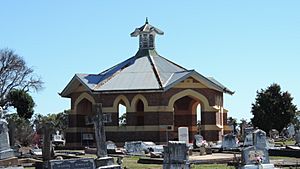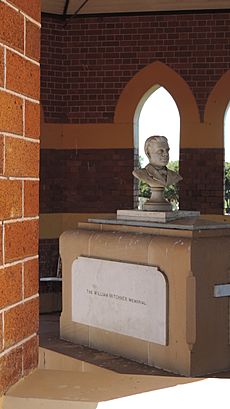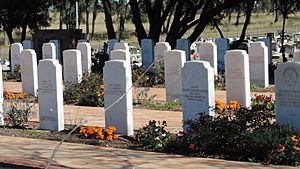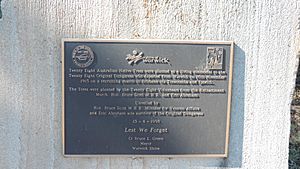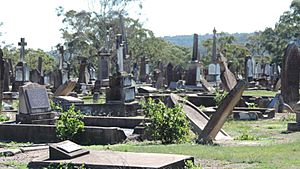Warwick General Cemetery facts for kids
Quick facts for kids Warwick General Cemetery |
|
|---|---|
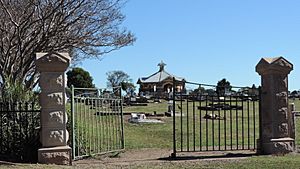
Warwick General Cemetery, 2015
|
|
| Location | Wentworth Street, Warwick, Southern Downs Region, Queensland, Australia |
| Design period | 1840s - 1860s (mid-19th century) |
| Built | 1853 - |
| Architect | Dornbusch & Connolly |
| Architectural style(s) | Gothic |
| Official name: Warwick General Cemetery | |
| Type | state heritage (built) |
| Designated | 27 April 2001 |
| Reference no. | 602152 |
| Significant period | 1853- ongoing (fabric, historical use) |
| Significant components | memorial/monument, pathway/walkway, crypt / vault, shed - shelter, headstone, gate - entrance, grave marker, denominational divisions, road/roadway, burial/grave, tower - bell / belfry, seating, memorial - pavilion, sculpture, plaque, columbarium, grave surrounds/railings |
| Builders | Phil Thornton |
| Lua error in Module:Location_map at line 420: attempt to index field 'wikibase' (a nil value). | |
The Warwick General Cemetery is a special place in Warwick, Australia. It's like an outdoor museum that tells the story of the town and its people. This historic cemetery was designed by Dornbusch & Connolly and started being built in 1853 by Phil Thornton. It's so important that it was added to the Queensland Heritage Register in 2001.
A Look Back in Time
The first part of the Warwick General Cemetery was planned in 1850. This was when the town of Warwick was first officially set up. The very first known burial here happened in 1853.
The cemetery is on a raised area near the Condamine River. It has always been divided into different sections for various religious groups. You can find many monuments and memorials here. They honor people who lived in Warwick and the areas nearby. One important structure is the William Mitchner Shelter-shed.
Early Days of the Cemetery
In the 1840s, people started moving into the Darling Downs area. The town of Warwick was then created in the late 1840s. It was a center for the surrounding farms and ranches. In 1850, a survey set aside 8 acres for a general cemetery.
The first known burial in the cemetery was Thomas Howard in 1853. Later, in 1864, some land was set aside for the Church of England. Over time, more land was added for the cemetery as it grew.
Managing the Cemetery
Managing the cemetery wasn't always easy! In 1859, someone complained that it needed a fence to keep pigs out. Later, in 1867, people worried about cows grazing there.
In 1865, a law was passed to help manage cemeteries. In 1868, five trustees were chosen to look after the Warwick General Cemetery. They set up rules and fees. Before this, there weren't many official records.
By 1898, the trustees needed more land for burials. They added more areas, and the Warwick Cemetery Reserve grew. In 1908, new trustees were officially named for the larger 56½-acre cemetery.
The trustees earned money from selling grave plots and burials. They used this money to pay the caretaker and for upkeep. They were careful with their spending. For example, they didn't fence the new land until it became crowded in 1903.
The William Mitchner Shelter-shed
In 1914, the Cemetery Trustees wanted to build a rest-house. Local architects Dornbusch and Connolly drew up plans for a timber building. However, it wasn't built until William Mitchner left money for it in his will.
The William Mitchner Shelter-shed was built in 1926. It's a large, octagonal building made of brick and tin. It stands in the middle of the cemetery. William Mitchner was born in Germany in 1841 and passed away in 1918. He left £1,500 to build this memorial.
He had very specific instructions for the shelter. It had to be made of brick. It needed a marble monument with a cross, surrounded by railings. It also had to have a vault for his body and a plaster bust of himself. He wanted a steeple, a bell, and a belfry. The bell was meant to ring when a funeral was coming.
William Mitchner was an investor who owned property in several towns. He left money to hospitals and churches. Because Australia was at war with Germany when he died, there were some legal issues with his will. This might be why the shelter wasn't built until 1926.
Dornbusch and Connolly designed the shelter. Phil Thornton built it for £1,236. The shelter has a bell tower and seats inside. It includes a vault with marble crosses and a plaque about William Mitchner. A bust of him stands above the vault.
Changes in Management
Over the years, the management of the cemetery changed. By 1936, the Warwick City Council started looking after it. In 1938, the Council wanted to build a sewerage treatment plant in the northern part of the cemetery.
After some discussion, the Council officially became the new trustees of the cemetery in 1940. The sewerage works were finished in the 1940s.
War Graves and Other Sections
In 1946, the Warwick City Council and the Commonwealth War Graves Commission created the Warwick War Graves Cemetery. This section holds the graves of soldiers. A special area was also set aside for returned servicemen.
In 1964, a section for a columbarium was added. This is a place where urns holding ashes are kept. The first burial here happened in 1972.
Later, parts of the cemetery land were used for a council depot and sewerage works. The cemetery's size was reduced to about 13.63 hectares (30 acres).
In the late 1990s, the Warwick War Cemetery was updated. It now includes a new lawn cemetery and memorials for fallen servicemen. In 1998, 28 trees were planted nearby. They honor the "Dungaree" recruits who left Warwick in 1915 to fight in the First World War.
Notable Burials
Many interesting people are buried here.
- James Jackson (died 1863) is known for starting Freemasonry in Queensland.
- Dr. Jonathon Labatt (died 1869) was an early doctor from Ireland.
- Octavius Frederick Farquharson (died 1867) was only 22 when he died after falling from his horse.
- Andrew Fitzherbert Evans (died 1870) was Warwick's first Clerk of Petty Sessions.
- St. George Richard Gore (died 1871) was an early rancher and a politician.
- John Deuchar (died 1872) was a sheep farmer who built the famous Glengallan Homestead.
- James Morgan (died 1878) helped Warwick become a municipality. He was also a politician and newspaper editor.
- Some graves belong to South Sea Islanders from 1879 and 1881.
- James Caulfield (died 1880) died in a railway blasting accident.
There are also many children's graves, showing how high child mortality used to be. The Clark family gravestone, for example, marks three children who died young. Their father, Charles Clark, was a well-known wool farmer.
Immigrants are also buried here, like Frederich Reimers (died 1915) from Germany. He was a cabinetmaker and undertaker in Warwick. John McCulloch (died 1918) was Warwick's first stonemason. He made many of the cemetery's monuments.
Monsignor Michael Potter (died 1944) was a Catholic priest. He was called "the Builder" because he helped build many churches. The Sterne family plot includes Henry Sterne (died 1954), an alderman and newspaper editor. His wife, Elizabeth Sterne OBE, was involved in many community groups.
Chinese Burials
Many Chinese immigrants worked as shepherds, servants, and gardeners. Later, more came for gold and tin mining. Between 1875 and 1919, many Chinese people were buried in the "pagan section" of the cemetery. While some remains were later sent back to China, some marked graves still exist. The Council is working to recognize the contribution of these immigrants.
What You Can See Today
The Warwick General Cemetery has different sections. The oldest graves are at the northern end. From there, it's divided into areas for Pagan, Jewish, Methodist, Congregational, Presbyterian, Catholic, and Church of England burials. The southern end also has different sections.
The highest point of the cemetery is where the Mitchner Memorial Shelter-shed stands. The land gently slopes down from there.
Cemetery Layout
The fence along Wentworth Street has gates with sandstone pillars. These mark the entrance to each section. Inside, roads and paths create a grid pattern. They divide the cemetery into its religious sections. A road also separates the lawn graves from the older monumental sections.
The Mitchner Memorial Shelter-shed
The most noticeable building is the Mitchner Memorial Shelter-shed. It's in the Church of England section. This building is octagonal (eight-sided). It's made of thick brickwork. The openings on the four main directions have pointed "gothic" arches. Other walls have smaller gothic arches without glass.
On top of the corrugated iron roof is a ventilated octagonal timber belfry with a bell inside. The belfry and roofs have wide, low-pitched gables over each door. The corners have buttresses, and stucco bands give it a horizontal look.
Inside, the floor is concrete, and the ceiling is made of wood. Long wooden seats are placed along the walls. A sandstone vault is in the center. It has marble plaques with crosses on each end. One plaque says: "The William Mitchner Memorial This shelter shed is the gift of William Mitchner for the benefit of the public Under this stone lies his body Born August 2, 1841 Died Jude 1st 1918". A marble bust of William Mitchner stands above the vault.
Near this shelter, there's an E-shaped columbarium (built around 1972). It's protected by a modern garden.
Headstones and Memorials
Many tombstones were made by local stonemasons, like James McCulloch. Others were brought from far away. Gravestones come in many styles. Some are simple upright tablets. Others are more detailed, like obelisks, broken columns, or crosses. You can also see urn-topped columns and heart-shaped memorials. War graves are simple white slabs with brass plaques.
One unusual memorial is a "bodystone." It's a horizontal tombstone shaped like a coffin. A 1908 memorial for a wife who died soon after her marriage shows a marble angel. It looks like it's dropping flowers onto her grave. A 1924 memorial for a young man features a football and a broken column. This symbolizes a life that ended too soon.
A 1942 grave of a farmer has a small kingfisher bird in a glass-fronted niche. This is at the base of his heart-shaped black granite headstone. It also has fern sprays and a dove.
Inscriptions and Grave Plots
The words on the gravestones tell many stories. They can give you information about the person's life, where they were born, and how they died. For example, the 1866 gravestone of Elizabeth Diamond Hammersley says she was a servant. The McLeod tombstone, for two young children who died in 1864, suggests a tragedy.
Some inscriptions include the person's job, like "painter." Others tell you their birthplace, such as "native of Westmeath, Ireland." Inscriptions also show if it's for one person or a family. In the Jewish section, a memorial for two children has writing in both Hebrew and English. The few Chinese memorials have inscriptions in Chinese characters.
Grave plots can be for one person or a whole family. Some older graves have cast-iron fences, like the Clark family's plot. Most graves have a concrete border.
While there are pine trees along the road near the Lawn Cemetery, fewer trees are in the older parts. Graves in the older sections sometimes look crowded. The paths and graves aren't as neatly arranged as in the newer sections (after the 1930s).
The cemetery is generally well looked after. However, in the older parts, some monuments have worn down. Others lean at odd angles.
Why It's a Heritage Site
The Warwick General Cemetery was added to the Queensland Heritage Register in 2001. This means it's a very important place.
- It shows Queensland's history: The cemetery helps us understand how Queensland's history unfolded. It shows the jobs, social standing, and different groups of people in Warwick since the 1850s. It's one of Queensland's oldest cemeteries.
- It shows what a cemetery should be like: It's a great example of a historic cemetery. The different headstones and monuments show how people have remembered the dead over time. They reflect Warwick's social, religious, and architectural history from the 1850s to today.
- It's beautiful: The design of the Mitchner Shelter-shed and its central spot are beautiful. The variety of headstones, the grounds, and the way the graves are arranged also make it special.
- It's important to the community: The large Mitchner Shelter-shed was a gift from William Mitchner to the community. It's a place for rest during funerals, for visitors, and for shelter. It has a strong connection with the Warwick community for social, cultural, and spiritual reasons.
- It's linked to important people: The cemetery is connected to many important people and families. These individuals helped shape the history of Warwick and the surrounding area.


